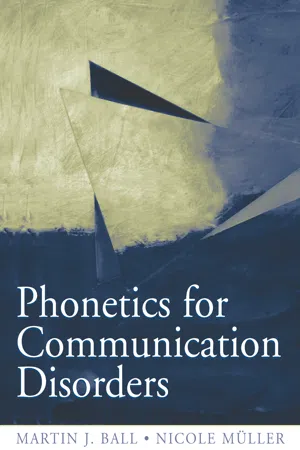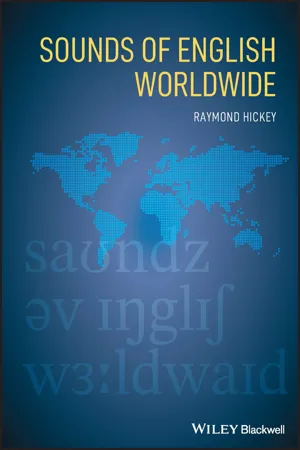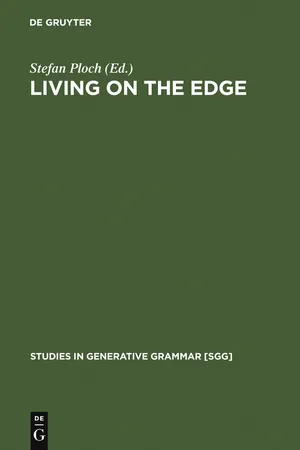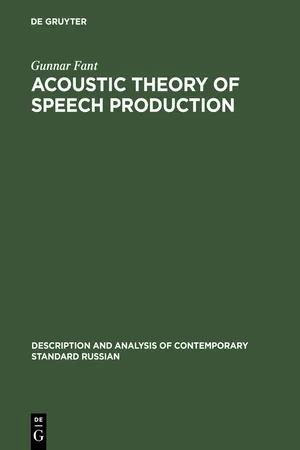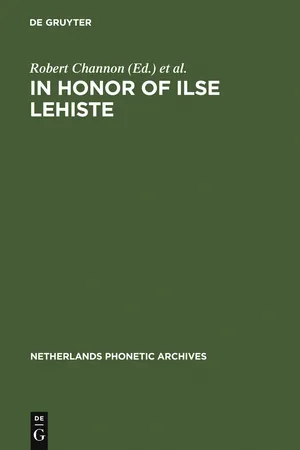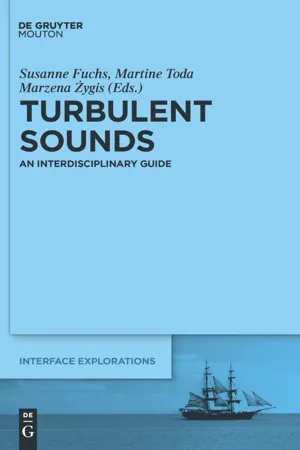Languages & Linguistics
Affricates
Affricates are consonant sounds that begin as a plosive (complete closure of the vocal tract) and then release into a fricative (partial closure causing turbulence). They are produced by briefly stopping the airflow and then releasing it with friction. Examples of affricates include the "ch" sound in "church" and the "j" sound in "judge."
Written by Perlego with AI-assistance
Related key terms
1 of 5
8 Key excerpts on "Affricates"
- eBook - PDF
- Martin J. Ball, Nicole Muller(Authors)
- 2014(Publication Date)
- Psychology Press(Publisher)
This doesn't last long enough to make us consider the sounds Affricates, so we call them affricated stops. Figure 8.5 shows how the release phase is modified to force the air through a narrow channel and thus produce the turbulence. In IPA these affricated stops are shown by adding a small superscript version of the fricative symbol after the plosive. Let's consider some examples from Liverpool, England: cake and tea may be pronounced [kXelkXl and [tSil. MULTIPLE ARTICULATIONS As we saw in chapter 7, the main active articulators are the lower lip and various parts of the tongue. The tongue itself is extremely flexible and the tip and blade are able to move independently of the back of the tongue. This, coupled to the fact that the lips are of course separate from the tongue altogether, means it is feasible to produce articulations at two different places at the same time. We will see that such multiple articulations are usually divided into two categories: double articulations and secondary articulations. Double Articulations With double articulations the two strictures (i.e., coming together of articulators) will be in different places, but must be of the same manner. In other words, we can have plosive stops made at the bilabial and velar places of articulation, we can have fricatives made at the postalveolar and velar places of articulation, and we can have approximants made at the bilabial and palatal places of articulation. In each instance we have two of the same manner of articulation: two stops, two fricatives, two approximants. Remember: in these sounds the two articulations occur simultaneously. MORE ON CONSONANTS 97 FIG 8.6 Double articulation (labia-velar). Such double articulations are quite common in natural language. In fact all the examples we quoted in the previous paragraph occur quite frequently. - eBook - PDF
Phonological Representation and Phonetic Phasing
Affricates and Laryngeals
- Wolfgang Kehrein(Author)
- 2013(Publication Date)
- De Gruyter(Publisher)
It is hard to imagine that something which 31 plays no role in underlying representation should nevertheless be visible for matters of phonological behavior. On the other hand, Affricates are the very case where such a scenario has actually been proposed, most explicitly through 'release projection' in APERTURE THEORY (Steriade 1993, 1994, cf. 2.3). What remains to be shown in this chapter, then, is that affricateness is irrelevant for the phonology as well. Positively stated, Affricates behave just like the GENERALIZED STOP APPROACH predicts: first, they form a natural class with stops (2.5.1). Second, a class of all Affricates does not exist; apparent counterexamples provide evidence instead for strident, lateral and nasal Affricates forming a natural class vs. stops and non-strident Affricates (2.5.2). Finally, 2.5.3 shows that Affricates do not form a natural class with fricatives; rather, strident, lateral, and nasal Affricates form natural classes with their corresponding fricatives (and sonorants) only, and non-strident Affricates have no connection to fricatives at all (apart from PLACE and [obstruent], of course). 2.5.1 Affricates and stops form a natural class There is abundant evidence from all areas of phonology that stops and Affricates share the STRICTURE feature [stop]. In the examples in (35), for instance, stops and Affricates pattern together to the exclusion of fricatives. Notice that the phenomena listed below cover a wide range such as coda restrictions, postnasal voicing, postnasal strengthening ('stopping'), and weakening ('spirantization'). (35) Summary from the literature: Affricates as [stop] (Lombardi 1990; Schafer 1995) LANGUAGE type phenomenon Italian, Chipewyan, Chiri. - eBook - PDF
- Raymond Hickey(Author)
- 2023(Publication Date)
- Wiley-Blackwell(Publisher)
Consonants fall into natural groups depending on certain features they may show. For instance, stops are consonants in which there is a full obstruction of air during their articulation, e.g. with /p, t, k/. Fricatives are those in which there is a partial blockage of air which leads to air turbulence at the point of articulation, e.g. with /f, θ, s, ʃ/. Another common fricative is /x/, which no longer exists in English, but is found in Spanish, German, and Russian, for instance. Certain consonants consist of combinations of a stop and a fricative to produce an affricate, e.g. /tʃ/. English has a sound sequence /ts/, as in bits [bɪts], but because the sounds do not act as a unit, as they do in German or Russian, for instance, they do not constitute a phonological affricate: there is no instance of /ts/ where the /s/ is not a plural ending, i.e. there is no word in English like /tsaɪt/ (German Zeit ‘time’) or /tsel j / (Russian tselj ‘aim’). The reverse is true of Affricates: for instance, with /tʃ/ or /dʒ/ there are no cases where they can be bro- ken up into their constituents sounds /t/ and /ʃ/ or /d/ and /ʒ/ respectively. These are phonological reasons for regarding Affricates as single units from the perspective of the sound system of English. Classifying Consonants in English It might at times be expedient to classify consonants using a minimum amount of information, for instance, if you merely wish to distinguish systemic segments from one another. To do this for obstruents in English one needs to specify three parameters for each sound: (i) place of 2.3 onsonnts 73 articulation, (ii) manner of articulation, and (iii) voice. 7 The last parameter is binary: present or not present. The other two involve a number of values. Place of articulation can have any of seven values in English; in Table I.20 these are listed from left to right labeling positions at the exit of the mouth back to the throat (see Figure I.16). - eBook - PDF
Living on the Edge
28 Papers in Honour of Jonathan Kaye
- Stefan Ploch(Author)
- 2011(Publication Date)
- De Gruyter Mouton(Publisher)
The presence of the latter within a segmental expression provokes a minimally sonorant sound. Finally, the view on spirantisation and Affricates developed here has direct consequences for consonantal representations. Since affri-cates are surrogate stops replacing default simple stops for places that involve A, the presence of this prime may be calculated from the distribution of Affricates. Namely, the fricatives of places whose stops are Affricates must contain A, whereas the fricatives of places for which simplex stops exist lack this prime. By this means, frica-tives are identified as belonging to two subgroups: one possessing, the other lacking A. 298 Tobias Scheer (12) Fricatives and their occlusive partners Fricatives Related stops: Fricatives Related stops: lacking A simplex possessing A Affricates Φ, ß p, b f,v JL I θ,0 : t,d s, ζ ts, dz 9>i c, ) 9, ? tc, d? m L·2L· gκ . k, g I> 3 ':· ft, ί q, G X, * - h,fi ? We know from independent evidence that the fricatives in grey-shaded cells do bear A despite the fact that they relate to a simplex stop. Pharyngeals and glottals are co-defined by A because this prime is the identificational property of the class of gutturals (cf. section 2). The deviance of guttural articulations as a whole with respect to the generalisation at hand is not surprising when considering the fact that there are no postvelar Affricates at all. As for interdentale, we know that they possess A because they are the result of this prime incorpo-rating [t, d] in Grimm's Law. Their exceptional behaviour does not need any further comment anymore. Thus, the only fricatives that really lack A are bilabials, palatals and velars. The opposition based on the presence versus absence of A also has an acoustic manifestation. Indeed, it is the mere phonological identi-fication of the Jakobsonian opposition strident versus mate. - eBook - ePub
- William F. Katz(Author)
- 2013(Publication Date)
- For Dummies(Publisher)
h / is wild and crazy, but I say you give it a home in the fricative category (as long as you remember it may not always stay put).Going in Half and HalfAffricates are a combination of a stop followed by a fricative. English has two affricate phonemes: /ʧ / and /ʤ /. In the IPA chart, /ʧ / and /ʤ / are listed as post-alveolar (produced by placing the tongue front just behind the alveolar ridge) because this place of articulation corresponds to the major part of the sound — namely, the fricative.In some situations in English, a stop butts up against a homorganic (sharing the same place of articulation) fricative, creating situations that may seem “affricate-like.” However, these instances aren’t true Affricates. For example, the sound /t / can sometimes adjoin the sound /s /, as in the phrase “It seems.”However, to demonstrate that this phrase isn’t a true affricate, you couldn’t get away with new English expressions, such as “ts ello,” “ts ow are you?” and so on, and expect anyone to think you’re speaking English. This is because /ts / can’t stand alone as an English phoneme (although in other languages, such as Japanese, a /ts / affricate phoneme is found, such as in the word “tsunami” ).Shaping Your ApproximantsApproximants are formed by bringing the articulators together, close enough to shape sound, but not so close that friction is created. The English voiced approximant phonemes are /w /, /ɹ /, /j /, and /l /, as illustrated in the phrase “your whirlies” /jɚr 'wɪɹliz /. In addition to this set, “hw” (written in IPA with the symbol /ʍ /) is produced by some talkers as an alternative to voiced /w / for some words. Some pronounce “whip” or “whether” with a /w /, and others with a /ʍ /. In most forms of English, the use of /ʍ - eBook - PDF
Acoustic Theory of Speech Production
With Calculations based on X-Ray Studies of Russian Articulations
- Gunnar Fant(Author)
- 2012(Publication Date)
- De Gruyter Mouton(Publisher)
2.6 FRICATIVES, Affricates, AND STOPS 2.61 Fricatives and Affricates The previous sections have been devoted to the study of the vocal tract response to a voice source. Whispered liquids and vowels should theoretically differ from voiced variants mainly by the random fine structure and more high frequency emphasized spectrum envelope of the source, owing to the glottis noise source. However, the production of these vocalic sounds may also involve noise produced at a supraglottal constriction. Such noise is not a necessary attribute but may add noticeably to the sound spectrum in, for instance, a stressed [i], [1], or [r]. The first part of a liquid following an unvoiced consonant may assimilate the lack of voicing and thus becomes aspirated 1 or even fricative, with reference to noise generation at a narrow supraglottal passage, as discussed in Sections 1.11 and A.22. Acoustically, the common denominator of all sounds produced from a resonator system of a prescribed configuration is the particular set of formant frequencies of the vocal tract, i.e., the F-pattern. The differences in location of the source and the spectrum envelope of the source will only influence the relative intensity levels of the formants. It is to be expected that the cavities in front of and in the vicinity of a source will be of major importance for the spectral shape of any sound. One complication that must be taken into account is the influence of the glottis-opening on formant frequencies and formant damping. The first formant is raised in frequency and highly damped when the glottis area is large. These general relations are common to all sounds that are produced in part or solely from a supraglottal source, thus also to stops, Affricates, and fricatives. - eBook - PDF
In honor of Ilse Lehiste
Ilse Lehiste Pühendusteos
- Robert Channon, Linda Shockey, Robert Channon, Linda Shockey(Authors)
- 2011(Publication Date)
- De Gruyter Mouton(Publisher)
The Formation, Analysis and Perception of Hungarian Affricates Tamäs Tarnoczy, Research Laboratories of Natural Sciences, Hungarian Academy of Sciences, Budapest, Hungary 1. INTRODUCTION During the last 50 years the so-called 'affricate problem' has been prominent in Hungarian linguistic literature. Debates have been going on as to whether an affricate should be considered to be a single sound or a sequence of two sounds. Gombocz and Meyer (1909) established experimentally that they are sound sequences and Gombocz (1940:34) also says, By 'affricate' the linkage of a stop sound and a homorganic fricative is meant [trans, mine - T.T.]. This thesis has been attacked by Hungarian linguists, starting with Horger (1935), who argued against the phonological and historical linguistic view-points in favor of the one-sound theory. The opposing school of phoneticians, especially Hegedüs (1939), supported the two-sound theory on the basis of the results of experimental investigation. 1 Of course, when looking for arguments, non-Hungarian linguistic authori-ties were also cited. Those speaking in favor of the two-sound theory referred to linguists like Jespersen, Forchhammer and Passy, while those supporting the one-sound theory quoted the opinion of Rousselot, Roudet and Jones. A good survey of the entire literature until 1944 is given in Laziczius (1944). It should be noted, however, that such phonetic investigations were no more than time analyses made on the basis of kymograms and oscillograms; these were later supplemented by the use of sonagrams, which were little more convincing. Hegedüs also made use of the tone recorder and in his posthumous article (Hegedüs, 1958) drew a distinction in his results between langue and parole. According to this an affricate is two adjacent sounds which, however, form a linguistic unit. - eBook - PDF
Turbulent Sounds
An Interdisciplinary Guide
- Susanne Fuchs, Martine Toda, Marzena Zygis, Susanne Fuchs, Martine Toda, Marzena Zygis(Authors)
- 2010(Publication Date)
- De Gruyter Mouton(Publisher)
An overview of the phonology of obstruents ∗ T. A. Hall and Marzena ĩ ygis 1. Introduction Sounds in the languages of the world involving turbulent noise are referred to in generative phonology as ‘obstruents’, a natural class subsuming stops, Affricates and fricatives. Sounds not belonging to the class of obstruents are traditionally considered to be ‘sonorants’, namely vowels, glides, liquids, nasals. The purpose of this article is to provide an overview of the phonology of obstruents, concentrating on the three subcategories ‘stops’, ‘Affricates’ and ‘fricatives’ and the rules in natural languages which change a sound from one of those categories to a sound in one of the other two. We begin in section 2 by discussing the distinctive feature used for capturing the sonorant vs. obstruent dimension ([sonorant]). In section 3 and 4 we turn to the features used to express the contrast between stops vs. Affricates ([strident]) and stops vs. fricatives ([continuant]), respectively. In each section we discuss traditional definitions of the respective features as well as rules in a wide variety of languages which change the values of one of these features, e.g. obstruent → sonorant, stop → affricate, stop → fricative (and the respective mirror image rules). In section 5 we provide examples of processes which are problematic in terms of features but which can be explained if phonetic evidence (in addition to the phonological features) is taken into account. The aim of that section is to show the limits of feature theory – at least in its current state. Although a number of works have appeared through the years which analyse the kinds of rules we discuss below, a number of controversial issues relating to feature theory remain.
Index pages curate the most relevant extracts from our library of academic textbooks. They’ve been created using an in-house natural language model (NLM), each adding context and meaning to key research topics.
